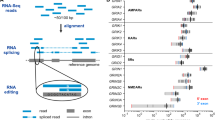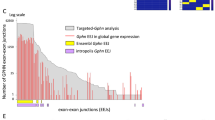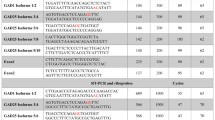Abstract
Inhibitory neurotransmission in the mammalian brain is principally mediated by γ-aminobutyric acid (GABA) acting through different subtypes of cell membrane GABA receptor (GABAR). The expression of one GABAR gene, GABABR1, is distinguished by the expression of multiple splice variants that encode different isoforms of the receptor. In the present study, we have identified two novel GABABR1 variants, GABABR1h (R1h) and GABABR1i (R1i), which appear to arise from alternative splicing of the GABABR1 gene. The expression of R1h and R1i is differentially regulated in brain and peripheral tissues, but expression is not altered in the brain of a genetic model of absence epilepsy (GAERS rat [genetic absence epilepsy rat from Strasbourg]). Both the R1h and R1i variants exhibit a novel 80-bp insert downstream of exon 4 that is flanked by consensus splice sites, and both encode C-terminal-truncated proteins. The new insight into the family of GABABR1 variants gained from this study identifies exon 4 as a preferred locus, or hot spot for regulated splicing in the GABABR1 gene. This finding correlates with the micro-exonic nature of exon 4 (21 bp). Bioinformatic analysis of micro-exon 4 and its flanking pre-mRNA sequences has revealed multiple, potentially competitive, exonic splicing enhancers that provide a mechanistic basis for the preponderance of alternative splicing events at this locus. Conservation of GABABR1 micro-exon 4 across species suggests a conserved functional role, facilitating either N-terminal protein production or post-transcriptional gene regulation through regulated splicing coupled to transcript decay.
Similar content being viewed by others
References
Altschul S. F., Gish W., Miller W., Myers E. W., and Lipman D. J. (1990) Basic local alignment search tool. J. Mol. Biol. 215, 403–410.
Bettler B., Kaupmann K., Mosbacher J., and Gassmann M. (2004) Molecular structure and physiological functions of GABA(B) receptors. Physiol. Rev. 84, 835–867.
Cartegni L., Wang J., Zhu Z., Zhang M. Q., and Krainer A. R. (2003) ESEfinder: a web resource to identify exonic splicing enhancers. Nucleic Acids Res. 31, 3568–3571.
Crunelli V. and Leresche N. (2002) Childhood absence epilepsy: genes, channels, neurons and networks. Nat. Rev. Neurosci. 3, 371–382.
Danober L., Deransart C., Depaulis A., Vergnes M., and Marescaux C. (1998) Pathophysiological mechanisms of genetic absence epilepsy in the rat. Prog. Neurobiol. 55, 27–57.
Dredge B. K., Polydorides A. D., and Darnell R. B. (2001) The splice of life: alternative splicing and neurological disease. Nat. Rev. Neurosci. 2, 43–50.
Fairbrother W. G., Yeh R. F., Sharp P. A., and Burge C. B. (2002) Predictive identification of exonic splicing enhancers in human genes. Science 297, 1007–1013.
Glowinski J. and Iversen L. L. (1966) Regional studies of catecholamines in the rat brain. I. The disposition of [3H]norepinephrine, [3H]dopamine and [3H]dopa in various regions of the brain. J. Neurochem. 13, 655–669.
Green R. E., Lewis B. P., Hillman R. T., Blanchette M., Lareau L. F., Garnett A. T., et al. (2003) Widespread predicted nonsense-mediated mRNA decay of alternatively spliced transcripts of human normal and disease genes. Bioinformatics 19(Suppl. 1), 118–121.
Holter J., Carter D., Leresche N., Crunelli V., and Vincent P. (2005) A mutation in the TASK3 channel (KCNK9) in a genetic model of absence epilepsy. J. Mol. Neurosci. 25, 37–52.
Holter J. L., Humphries A., Crunelli V., and Carter D. A. (2001) Optimisation of methods for selecting candidate genes from cDNA array screens: application to rat brain punches and pineal. J. Neurosci. Methods 112, 173–184.
Johnson J. M., Castle J., Garrett-Engele P., Kan Z., Loerch P. M., Armour C. D., et al. (2003) Genome-wide survey of human alternative pre-mRNA splicing with exon junction microarrays. Science 302, 2141–2144.
Kato H. and Enjyoji K. (1991) Amino acid sequence and location of the disulfide bonds in bovine beta 2 glycoprotein I: the presence of five Sushi domains. Biochemistry 30, 11687–11694.
Kaupmann K., Huggel K., Heid J., Flor P. J., Bischoff S., Mickel S. J., et al. (1997) Expression cloning of GABA(B) receptors uncovers similarity to metabotropic glutamate receptors. Nature 386, 239–246.
Lewis B. P., Green R. E., and Brenner S. E. (2003) Evidence for the widespread coupling of alternative splicing and nonsense-mediated mRNA decay in humans. Proc. Natl. Acad. Sci. U. S. A. 100, 189–192.
Morgan H., Smith M., Burke Z., and Carter D. A. (2000) The transactivation-competentC-terminal domain of AF-9 is expressed within a sexually dimorphic transcript in rat pituitary. FASEB J. 14, 1109–1116.
Purves D., Augustine G. J., Fitzpatrick D., Katz L. C., LaMantia A.-S., McNamara J. O., eds. (1997) in Neuroscience, Sinauer, Sunderland, MA: p. 111.
Sambrook J., Fritsch E. F., and Maniatis T. (1989) Molecular Cloning: A Laboratory Mannual, 2nd ed., Cold Spring Harbor Laboratory Press, Cold Spring Harbor, NY.
Sorek R., Shamir R., and Ast G. (2004) How prevalent is functional alternative splicing in the human genome? Trends Genet. 20, 68–71.
Stamm S., Zhu J., Nakai K., Stoilov P., Stoss O., and Zhang M. Q. (2000) An alternative-exon database and its statistical analysis. DNA Cell Biol. 19, 739–756.
Volfovsky N., Haas B. J., and Salzberg S. L. (2003) Computational discovery of internal micro-exons. Genome Res. 13, 1216–1221.
Wei K., Eubanks J. H., Francis J., Jia Z., and Snead O. C. III (2001a) Cloning and tissue distribution of a novel isoform of the rat GABA(B)R1 receptor subunit. Neuroreport 12, 833–837.
Wei K., Jia Z., Wang Y. T., Yang J., Liu C. C., and Snead O. C. III (2001b) Cloning and characterization of a novel variant of rat GABA(B)R1 with a truncated C-terminus. Brain Res. Mol. Brain Res. 89, 103–110.
Author information
Authors and Affiliations
Corresponding author
Rights and permissions
About this article
Cite this article
Holter, J., Davies, J., Leresche, N. et al. Identification of two further splice variants of GABABR1 characterizes the conserved micro-exon 4 as a hot spot for regulated splicing in the rat brain. J Mol Neurosci 26, 99–108 (2005). https://doi.org/10.1385/JMN:26:1:099
Received:
Accepted:
Issue Date:
DOI: https://doi.org/10.1385/JMN:26:1:099




